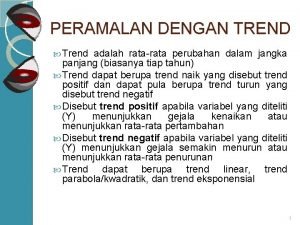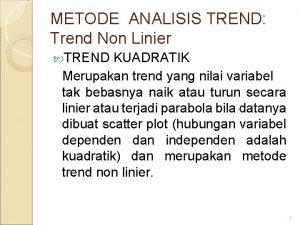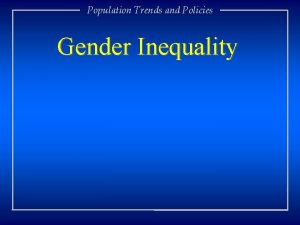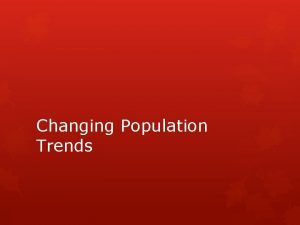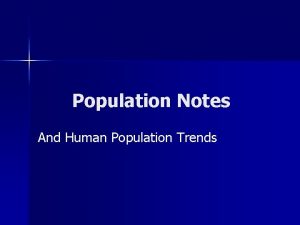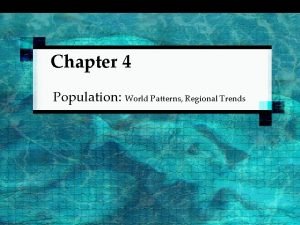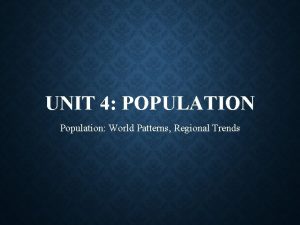MAKE THE TREND YOUR FRIEND Regional population trends













- Slides: 13

MAKE THE TREND YOUR FRIEND Regional population trends and how regions respond Development Officer Forum – Griffith 2018 Hayley Achurch – Senior Researcher

PRESENTATION OUTLINE Population trends – what is really happening in the regions? • Regional areas are growing – saying otherwise is damaging • Balance between declining young people and increasing over 55 s • But international migration is really making the difference How should regions work with these trends? • International migration should be the top priority, not the last resort • Positioning to take advantage of industry growth • Peoplecare – community driven and owned

ACROSS THE BOARD, REGIONAL POPULATIONS HAVE GROWN (2011 -2016)

MOST REGIONS LOSE YOUNG PEOPLE (NET INTERNAL MIGRATION 15 -24 YRS 2006 -2011)

INTERNATIONAL MIGRATION IS HAVING THE BIGGEST IMPACT IN REGIONS STRUGGLING FOR POPULATION GROWTH

INTERNATIONAL MIGRATION IS HAVING THE BIGGEST IMPACT IN REGIONS STRUGGLING FOR POPULATION GROWTH 2006 -2011 Bland Carrathool Coolamon Griffith Gundagai Hay Junee Leeton Lockhart Murrumbidgee Narrandera Snowy Valleys Temora Wagga Aust -146 -156 -2 212 -181 -451 139 36 -183 -352 -290 -110 -82 1570 O/S -1 12 10 502 52 5 31 -48 2 -26 21 157 28 985 2011 -2016 Aust O/S -514 46 -77 65 -50 -8 -285 504 -286 90 -260 18 16 68 -501 184 -86 13 -160 17 -303 12 -623 -3 128 42 276 1169

Distribution of Australia’s workers by age, industry and place of birth ALL INDUSTRIES Australian-born workers Aged under 30 years 27% Aged 50 years or over 41% Overseas-born workers 20% 44% AGRICULTURE, FORESTY AND FISHERIES INDUSTRY Australian-born workers Aged under 30 years Aged 50 years or over 16% 50% Overseas-born workers 24% 38% Source: 2016 Census of population and housing, customised data

LOCAL CONDITIONS EFFECT ON EMPLOYMENT CHANGE Agribusiness Production in the Riverina RDA (when removing national and industry growth trends) Bland Carrathool Coolamon Griffith Gundagai Hay Junee Leeton Lockhart Murrumbidgee Narrandera Snowy Valleys Temora Wagga -200 -150 -100 -50 0 50 Number of jobs 100 150 200

LOCAL CONDITIONS EFFECT ON EMPLOYMENT CHANGE Agribusiness Processing in the Riverina RDA (when removing national and industry growth trends) Bland Carrathool Coolamon Griffith Gundagai Hay Junee Leeton Lockhart Murrumbidgee Narrandera Snowy Valleys Temora Wagga -50 0 50 100 150 Number of jobs 200 250 300

LOCAL CONDITIONS EFFECT ON EMPLOYMENT CHANGE Tourism in the Riverina RDA (when removing national and industry growth trends) Bland Carrathool Coolamon Griffith Gundagai Hay Junee Leeton Lockhart Murrumbidgee Narrandera Snowy Valleys Temora Wagga -140 -120 -100 -80 -60 Number of jobs -40 -20 0 20

KEY MESSAGES Regional populations are growing across the board – saying otherwise is a damaging myth Don’t fight the demographic trends: • population strategies have focused on things that can’t easily change like stopping young people leaving To change the local population story, embrace the trends: • international migration should be the top priority • positioning to take advantage of industry growth

WE NEED ‘PEOPLECARE’ Many communities are proactive on these issues, but the effort is fragmented Landcare movement for developing regional populations • Community led response to population change • Connecting local groups active in population issues • Connecting existing residents to new arrivals • Harnessing existing volunteer and social capital base in regions Government flexibility to allow this to happen

STAY IN TOUCH: Regional Australia Institute www. regionalaustralia. org. au @Regional. Aus Hayley Achurch Hayley. Achurch@regionalaustralia. org. au https: //au. linkedin. com/in/Hayley. Achurch
 Hello my friend friend of a friend
Hello my friend friend of a friend Hello my future
Hello my future Accept your loneliness you are your only friend
Accept your loneliness you are your only friend How to introduce your friend to your teacher
How to introduce your friend to your teacher Postcard writing
Postcard writing Let's be good friends you and i
Let's be good friends you and i Foaf friend of a friend
Foaf friend of a friend A friend in needs a friend indeed
A friend in needs a friend indeed I've found a friend oh such a friend
I've found a friend oh such a friend Contoh forecast
Contoh forecast Contoh soal metode trend kuadratik
Contoh soal metode trend kuadratik Chapter 4 section 1 population dynamics
Chapter 4 section 1 population dynamics Section 1 population dynamics
Section 1 population dynamics Population ecology section 1 population dynamics
Population ecology section 1 population dynamics









